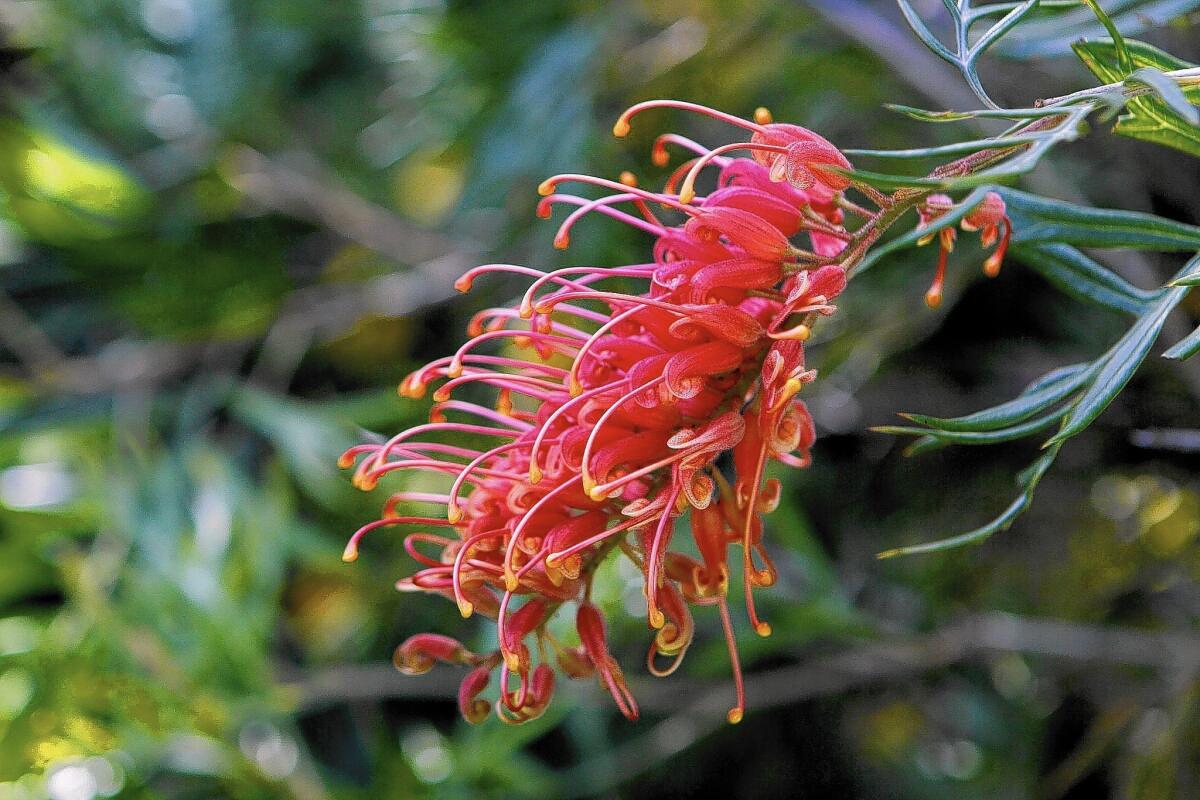Landscapes and plants in drought: Finding the best options for your garden

- Share via
Drought-tolerant trees: Grevillea, an Australian protea relative
Jose Manzo, manager of Seaside Gardens Nursery in Carpinteria, is a big proponent of Mediterranean-zoned trees, shrubs and perennials, which are less thirsty than other non-natives or exotic plants. One of his favorite choices is the grevillea, an Australian protea relative available in shrub and tree forms.
“These plants are bulletproof for most gardens,” Manzo says. “Grevilleas are easy to grow, they have a long bloom time and the hummingbirds love them.” With fine-textured, evergreen foliage and long, slender, curved flowers in warm-hot shades, this is a knockout landscape plant. A bonus: It won’t tolerate heavy irrigation, so grevillea is a great choice for the dry garden.
::
Water-wise lawns in drought: Plant diehard native plants; place rocks
Landscape architect Alison Terry of Terry Design in Fullerton specializes in sustainable landscape design and is a board member of the Mediterranean Garden Society.
“Right now, the drought is teaching me that in garden design less is more,” Terry says. “I’m trying to teach my clients to appreciate voids in their landscapes and not feel like they have to fill every space with plants. This allows the eye to rest in a landscape and creates a sense of calm, rather than frenetic energy.”
Terry incorporates gravel, boulders and permeable hardscape surfaces as a counterpoint to plants. For homeowners who don’t like to walk on gravel, she suggests laying concrete pavers or stepping stones separated by gravel or groundcover in between. “Decomposed granite is good too, but it sticks to shoes and dogs’ feet and gets tracked into the house, so I use that material for paths that are farther away from the house.” Gravel allows for more infiltration than decomposed granite, Terry advises.
“I use diehard California natives as the evergreen backbone for structure in the garden,” she says. “There are some plants that I use on almost every job; I sneak them in when I have to. They include: coffeeberry, manzanita (selected varieties such as ‘Howard McMinn,’ ‘Sunset’ and ‘John Dourley’); toyon; Pacific wax myrtle; and California lilac (such as ‘Concha,’ ‘Anchor Bay,’ ‘Joyce Coulter’ and ‘Yankee Point’).”
These natives are good substitutes for traditional evergreen landscape shrubs, Terry says. “Not only do they use less water, they also provide food for wildlife.”
::
For a Southern California garden in drought, try ornamental cultivars
When it comes to using less water in the landscape, Nicholas Staddon, director of new plant introductions for Monrovia Growers in Azusa, looks for ornamental selections of native plants.
“A lot of California natives really need special conditions to survive and thrive,” Staddon says. “And if most people have only natives in their gardens, they may find it an unemotionally satisfying place.”
So what’s the better option? “I seek out cultivars of native plants — those that bear more fruit or are more floriferous or perhaps have a better shape or form,” Staddon says.
A current favorite of his: Timeless Beauty, a selection of the desert willow. The deciduous shrub-tree has narrow, willow-shaped foliage and trumpet blossoms. A selection from Arizona that bears lavender-burgundy blooms, Timeless Beauty “hardly sets any seed, so it has a much longer blooming season than other varieties,” Staddon says.
In his own landscape, Staddon clusters plants closely so they can “share” water. “This creates shade for the roots,” he explains. “Coupled with a top-quality mulch that has water retention attributes, it’s a winning combination.”
For mulch, Staddon uses a mix of materials, including grass clippings, well-rotted horse manure from a local stable and bagged mulches from local garden centers.






